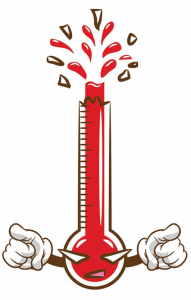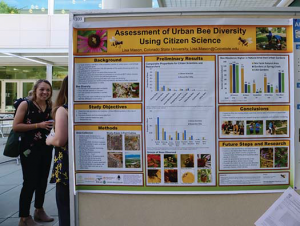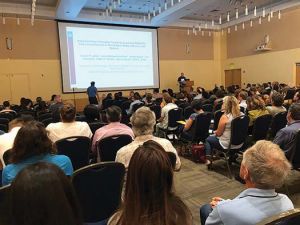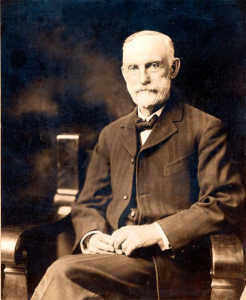Author: M.E.A. McNeil
Bee by bee, flower by flower, scientists are asking how climate change effects pollinators, and half a day was dedicated to their answers at the U.C. Davis International Pollinator Conference. In the keynote address, Christina Grozinger, director of the Center for Pollinator Research at Pennsylvania State University, said “Multiple interacting factors are driving the declines, including parasites and pathogens as well as biotic and abiotic [living and non-living] features of the landscape such as availability of forage, pesticide use, and climate.” That last factor, climate, is of critical importance.
 What was beyond question was whether there is any change. The scientists had the numbers by temperature, by elevation, by species, by bloom. Earth climate has always been changing, with CO2 levels rising and falling naturally over thousands of years. What is new is what is driving the change and the pace of it. Among the presenters was Jessica Forrest, of the University of Ottawa, who referred to the geologic age we are now in as the Anthropocene. The root “anthropo,” “human,” is combined with “-cene,” the standard suffix for “epoch” in geologic time. That is to say that fundamental earth system processes are now human-influenced, or anthropogenic. The signal is that a new epoch has begun, and, said Forrest, “What is unprecedented now is the rate in which climate change is coming.”
What was beyond question was whether there is any change. The scientists had the numbers by temperature, by elevation, by species, by bloom. Earth climate has always been changing, with CO2 levels rising and falling naturally over thousands of years. What is new is what is driving the change and the pace of it. Among the presenters was Jessica Forrest, of the University of Ottawa, who referred to the geologic age we are now in as the Anthropocene. The root “anthropo,” “human,” is combined with “-cene,” the standard suffix for “epoch” in geologic time. That is to say that fundamental earth system processes are now human-influenced, or anthropogenic. The signal is that a new epoch has begun, and, said Forrest, “What is unprecedented now is the rate in which climate change is coming.”
Although research on honey bees was presented over the three-day event, the scientists reporting on this subject work largely with wild bee species. Their reasons vary: Many native bees are valuable pollinators both commercially and in the wild; studying them eliminates some complex variables of eusocial honey bees; some can be studied in artificial, accessible nests; they are understudied, and some native species are endangered or feared extinct. It comes down to this: All of the pollinators are in the same environmental boat and it benefits all to have a look at that boat.
Warming is but one aspect of climate change and the one most researchers on this subject at the conference chose to focus on. “Global warming is the most powerful driver to the changing ecosystem,” said Gaku Kudo of Hokkaido University in Japan in his talk.
“Direct physiological impacts of warmer temperatures, reduction of floral rewards, and a brown bag of possible effects – that’s how I perceive the literature,” said Forrest.
“There are massive different effects of climate change, but number one is heat stress.”
 Temperature-related changes in flora have been mapped for some time. For example, in his work as a biological oceanographer at the Goddard Space Flight Center in Maryland, Wayne Esaias related satellite-tracked growth of phytoplankton in the world’s oceans to climate systems. As an EAS Master Beekeeper, his curiosity was triggered by seasonal changes he was observing with his backyard Maryland bees. He gathered and graphed hive weight records to indicate nectar flow from a battalion of beekeepers and found the data in sync with satellite photos and climate models over 22 years. He discovered a Smithsonian botanist’s log of bloom going back to 1970, and he identified a trend for “greening up” half a day earlier each year. At the time of his retirement in 2012, he concluded that bloom in his Maryland area has moved forward by about a month.
Temperature-related changes in flora have been mapped for some time. For example, in his work as a biological oceanographer at the Goddard Space Flight Center in Maryland, Wayne Esaias related satellite-tracked growth of phytoplankton in the world’s oceans to climate systems. As an EAS Master Beekeeper, his curiosity was triggered by seasonal changes he was observing with his backyard Maryland bees. He gathered and graphed hive weight records to indicate nectar flow from a battalion of beekeepers and found the data in sync with satellite photos and climate models over 22 years. He discovered a Smithsonian botanist’s log of bloom going back to 1970, and he identified a trend for “greening up” half a day earlier each year. At the time of his retirement in 2012, he concluded that bloom in his Maryland area has moved forward by about a month.
Esaias said that if those dates keep creeping forward, crucial plant-pollinator relationships could be in danger of getting out of sync. “Flowering plants and pollinators co-evolved. Pollination is the key event for a plant and for the pollinators in the year. That’s where pollinators get their food, and that’s what determines whether the plant will set fruit.” Some plant-pollinator pairs respond to the same environmental cues, but others do not – the pollinator emerging in response to temperature, for example, while the plant flowers in response to snow melt. In addition, a rogue freeze can play havoc with a bee cluster expanding in response to early warming. Those are questions that scientists reporting at Davis are researching, and let us count the ways.
Supply and Demand
Flowers respond to environmental cues. Grozinger’s talk contained a telling story about floral response from research on the Tibetan plateau. There, hives are more conveniently placed at roadsides, and flowers there produce less nectar than their relatives further afield, since they receive numerous bee visits and can pay less for the service.
When buckwheat, increasingly used for farm conservation, is stressed by drought, it reduces nectar production, pollinator visits and seed set. These findings by Rachel Mallinger, University of Florida, Jose Franco USDA ARS Booneville, and Caitlin Rering UC Davis were reported in a poster. The stressed flowers produced 42% less nectar and the nectar contained significantly lower ratios of sucrose to hexose sugars. Both seed set and mass declined. Pollinator visits by bees and flies dropped by nearly half, although something can be said for bumblebees: They showed no preference.
Temperature stress on the California native flower Penstemon herophyllus was studied by Kaleigh Russell and Quinn McFrederick of U.C. Riverside. They found that extreme temperatures affected nectar sugar concentrations and volume dramatically. Their continued work examines the effects of temperature change on microorganisms such as bacteria, fungus, and viruses associated with plants and pollinators.
 Caught in a Vise
Caught in a Vise
Mismatches can manifest in various ways. The bumblebee Bombus vosnesenkii, that once ranged from Southern California to Northern Oregon, is now rare or nonexistent in its southern range, according to a study by Michael Dillon of the University of Wyoming. Dillon is a physiologist connecting what he calls the macro ecological with physiology, and he finds that this bumblebee is caught in a climate vise.
“Insects are ectothermic,” he said, meaning that their body temperature is dependent on external sources. “You can measure their CT max [critical thermal maximum]. One test is to flip the creature over and see if it can flip itself back, that’s it, a temperature test.” His lab tested bees from across the range and found that those from southern latitude sites tolerate a minimum of 0°C (32°F). At the northern sites they could tolerate much more cold, -10° to -15°C (14° to 5°F); Dillon found that those bees have been stable along their northern range over a 75 to 100 year period. But a southern-bred bumblebee fleeing north encounters cold below its tolerance, stops grooming, walking and moving its antenna and eventually goes into chill coma. So Bombus v. in different ranges has different cold tolerance; the disappearing bees from the southern range may not be migrating but perishing. This bumblebee occupies a niche as early and late season pollinators for farmers and natural habitat that could suffer from its disappearance.
A retrospective of California bumblebee data over the last 150 years by Leif Richardson of the University of Vermont shows that the distribution of species has changed, in some cases quite a bit. More than half of all bumblebee species found in North America are in California – about 25 species, some of which are found continent-wide and many are important to agriculture.
“Temperature is the driving element,” he said. He found that although some plants and bee pollinators responding to climate change in parallel, there is evidence of climate-driven mismatch for other pairs of mutualists. “We found some common bumblebees tracking warming by advancing mean emergence date of foundress queens by up to three weeks, but some declining species are failing to track advancement of Spring in this way. That suggests that we have a potential for phenological mismatch,” he said.
The future can be studied in real time by observing pollinators in cities, according to Elsa Youngsteadt of North Carolina State University. Urban temperatures often average 1° to 3°C (34° to 37°F) warmer than the surrounding landscape. That puts cities ahead of the global-warming curve, and makes them extant labs for studying predictions about effects of climate change on pollinator health and abundance.
The NCSU research team set out pan traps, vane traps, and netting at 18 sites in Raleigh. Their sample included 3,593 individual bees of 113 species of wild bees. They found that total bee abundance declined by 41% per single degree Celsius (33.8° F) of warming. In the lab, they measured CT max for 15 common species using a heat-ramping assay. The bees with the lowest thermal tolerance were those whose populations declined the most with warming.
Housing Crunch
Another mismatch: Changing temperatures and precipitation levels in northern Arizona have negatively affected native tree populations and, subsequently, the nesting of Megachilidae bee species – the subject of the research of Lindsie McCabe of Northern Arizona University. The species in that diverse family range from floral specialists to floral generalists. Some are valuable for pollination, and their growing absence is being filled by flies.
Over three years, McCabe moved trapped colonies up and down by elevation. She found significantly poorer emergence at lower, warmer elevations, but she found a lack of nesting materials at high elevations – another vise. She concluded that artificial nesting blocks may help stabilize the population in northern Arizona. Her experiments with native and non-native wood nesting blocks showed that the bees were not picky.
Honey bees, too, have a stressed response to warming temperatures, as shown by the research of Alison McAfee, North Carolina State University. She exposed queens to temperatures from 5° to 42°C (41° to 107.6°F). The higher temperature reduced sperm viability in queens by 56% in four hours. Viability of ejaculated sperm was observed to diminish with heat. While 100% of queens survived after six hours at the highest tested temperature, only 42% of drones remained alive. McAfee conjectures that this sex-biased heat tolerance may be a way to ensure that queens are inseminated with high quality sperm. The grail for this research is identifying protein biomarkers that indicate temperature stress that can serve as useful diagnostics in the field.
Forrest reported that her lab studied the effect of warming on the gestational time of Osmia bees. They found that higher temperatures affect generational timing. With warming, most of the semivoltine (taking over a year to reproduce) bees shortened their normal two-year brood cycle to one year. “Last Summer was hot and dry, and [her lab] predicted that they would find more one-year bees in the wild, and they did. It was one of those rare occasions when I could say I understand how nature works,” she said.
The Osmia bees were studied in nests with removable paper straws with windows in them, so the brood could be examined. They found a brood parasitic wasp, Sapyga pumila, which lays its egg after the bee has just laid its egg. The wasp emerges first, eats the bee egg and its pollen provisions. The heat-driven increase in metabolic rate that expedited the bees’ brood cycle also accelerated the wasp’s development. So bees and predators are revved up, and the standoff favors neither. Forrest calls it a saturating relationship: “It’s pretty much a wash for the bees.” Except, as other presenters brought out, their heightened metabolism has a price.
“Time is the longest distance between two places.” – Tennessee Williams
Since 1990, Gaku Kudo, of Hokkaido University, has been studying the effects of climate change on ecosystems. He found, in an alpine environment in northern Japan, a phenological (timing of biological events) mismatch that occurs between bumblebees and bloom. Flowering onset was associated with surface thermal degree days after snowmelt, while bee emergence was determined by soil temperature. A mismatch occurs when the snow is warmed and melts early but subsequent soil warming progress slowly. Seed set was strongly related to the extent of mismatch in that ecosystem.
Flowering time varied from year to year with snow melt time, but the seasonal dynamics of bees were observed to be more conservative. Kudo found that such mismatches tend to occur early and late in the foraging season.
Charlotte de Keyzer, of the University of Toronto, has studied how climate change can alter environmental cues, whether organisms are tuned to the same cues, and the effects on pollination. The research, conducted in environmental chambers, involved pollinator Osmia lignaria and the flower Cercis Canadensis, which the bee prefers. The plant was more responsive to warmer forcing temperatures than the bee, as Kudo also observed among wildflowers in Japan, so female bees were more likely to emerge after the average date of first flowering. Over the last decade, she found, Osmia l. has been emerging about 1.2 days early while the flower has emerged 1.15 days earlier. De Keyzer says, “Mismatches are predicted to become more common in the future for most plant-pollinator interactions.”
Another such mismatch is possible, according to work done by Rachel Mallinger and Sarah Anderson of the University of Florida and presented on a poster. The southeastern blueberry bee, Habropoda laboriosa, is a large native bee that emerges early in spring. It is believed to be oligolectic (having a specialized pollen preference) on blueberries, Vaccinium spp. Because the blueberries have a short, early blooming period, phenological changes could make this bee susceptible. The research examined the changing phenology of H. laboriosa over 100 years. Over that time, the collection date for the bee advanced 44 days. Flowering for this blueberry species has advanced as well, but the specialized pollination relationship is a risk for both the bee and the plant.
Food Security
A study of the impacts of climate change on pollinators in Brazil was presented by Tereza Giannini, of the Federal University of Para. Some losses, she found “shocking.”
Many wild pollinators are important to agriculture in Brazil – 250 species pollinate 141 agricultural crops. Wild bees in the family Apidae were reportedly the most effective pollinators, mainly those from the genera Melipona, Xylocopa, Centris, and Bombus.
She used species distributional modeling to estimate future effects and found that the occurrence of these pollinators varied but could fall precipitously by 2050. In the national forest, the potential reduction of pollinating species ranges from 70% to 100%.
Giannini found probable decline in a large number of places where crop production is high – 20% to 90% of the GDP. Some southern areas are most vulnerable to warming, and that is where many people live who have the greatest socioeconomic vulnerability. In contrast, some parts of northern Brazil, particularly in the northwestern Amazon, could potentially benefit from climate change because pollinators of some crops may increase.
Her urgent plea is for conservation projects such as climate-refuge areas and ecological corridors to connect these areas to improve the climate-forced dispersal of species.
The Phoenix Rises from the Ashes
Some winners in the effects of climate change were found by John Mola, Michael Miller and Sean O’Rourke, in the lab of Neal Williams at U.C. Davis. The Northern California wildfires produced an increased blooming environment in the years immediately following burning. The researchers used a combination of genetic mark-recapture techniques and body size measurements of the bumblebee Bombus vosnesenskii both in and outside of the post-burn area. They found that the bees thrived on the rich environment, increasing forager size, colony abundance, and reproductive output.
Onward
Among many future projects for these researchers is a study in McQuinn’s lab of the effects of climate change on nectar-inhabiting microbial communities. Youngsteadt will explore how temperature-related changes in bees could affect pollination services. Dillon received a $1.17 million National Science Foundation grant to study how cold tolerance is determined by genetics in bumblebees. “The point of the new grant is to learn how you go from DNA to proteins to a trait like cold tolerance,” he said, with the hope that the understanding of the underlying genetics can be more broadly applied.
Scientists at the Davis conference caution that forecasting the impact of future warming requires understanding the complexities of factors that can affect population. But for now we are left with a question: Apple growers in Pennsylvania don’t need to rent bees, according to Grozinger, because they have so much background wild bee population. She asks, “How do we manage bees well so that they are stable?
Each finding at the Davis conference represents many hundreds of hours in the lab or traipsing through different terrains in every condition of heat and cold – counting, measuring, comparing. Clearly the results indicate the pollinators and their forage are affected by climate change. Each individual report may not be earthshaking, but taken together seriously, they may be Earth-changing.






